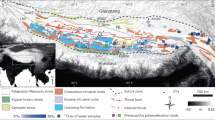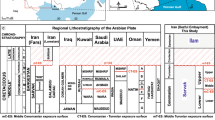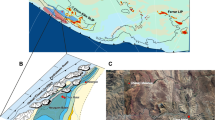Abstract
The Hadar fluvio-lacustrine formation (Ethiopia) contains an original hominid fossil Australopithecus afarensis and an abundant vertebrate faunal assemblage1,2. The formation3,4 consists of a 150–300 m thick sequence of fine-to-coarse detrital sediments, originating from the Ethiopian Plateau escarpment, with some interbedded pyroclastic layers. The three lower members of the formation were formed in a lacustrine environment, which was occasionally interrupted by fluvial drainage. The upper member is quite distinct and formed as an alluvial fan delta. This sedimentary sequence was deposited at the end of the Pliocene between 3.9 and 2.7 Myr, as indicated by magnetostratigraphy5 (the palaeomagnetic record spans the Gilbert–Gauss transition period), K/Ar dating6,7 and biostratigraphy8. We consider here the oxygen and carbon isotope variations observed throughout the formation and their palaeo-hydrological implications.
This is a preview of subscription content, access via your institution
Access options
Subscribe to this journal
Receive 51 print issues and online access
$199.00 per year
only $3.90 per issue
Buy this article
- Purchase on Springer Link
- Instant access to full article PDF
Prices may be subject to local taxes which are calculated during checkout
Similar content being viewed by others
References
Taieb, M., Johanson, C. C., Coppens, Y. & Tiercelin, J. J. C.r. hebd. Séanc. Acad. Sci., Paris D287, 237 (1978).
Johanson, D. C. & White, T. D. Science 202, 321 (1980).
Taieb, M. & Tiercelin, J. J. Proc. 8th Panafr. Congr. Prehist. Quat. Studies, Nairobi (1977).
Taieb, M. & Tiercelin, J. J. Bull. Soc. géol. Fr. 7, 3 243 (1979).
Schmitt, T. J. et al. Proc. 8th Panafr. Congr. Prehist. Quat. Studies, Nairobi (1977).
Aronson, J. L. et al. Nature 267, 323 (91977).
Walter, R. C. thesis, Case Western Reserve Univ., Cleveland (1980).
Beden, M. thesis, Univ. Poitiers (1980).
Tarutani, T., Clayton, R. N. & Mayeda, R. K. Geochim. cosmochim. Acta 33, 987 (1969).
Petit-Maire, N. et al. 26th int. Geol. Congr. Paris, Abstr. 681 (1980).
Gaven, C., Hillaire-Marcel, C. & Petit-Maire, N. Nature 290, 131 (1981).
Cerling, T. E., Hay, R. L. & O'Neil, J. R. Nature 267, 137 (1977).
Johnson, G. D. Nature 247, 520 (1974).
Monty, C. L. V. in Stromatolites (ed. Walter, R. M.) (Elsevier, Amsterdam, 1976).
Gasse, F., Fontes, J. C. & Rognon, P. Palaeogeogr. Palaeoclimatol. Palaeoecol. 15, 109 (1974).
Fontes, J. C. & Pouchan, P. C.r. hebd. Séanc. Acad. Sci., Paris D280, 383 (1975).
Rothe, P., Hoefs, J. & Sonne, V. Sedimentology 21, 373 (1974).
Deines, P. in Handbook of Environmental Isotope Geochemistry (eds Fritz, P. & Fontes J.-C.) (Elsevier, Amsterdam, 1980).
Leakey, M. D. & Hay, R. L. Nature 278, 317 (1979).
Author information
Authors and Affiliations
Rights and permissions
About this article
Cite this article
Hillaire-Marcel, C., Taieb, M., Tiercelin, J. et al. A 1.2-Myr record of isotopic changes in a late Pliocene Rift Lake, Ethiopia. Nature 296, 640–642 (1982). https://doi.org/10.1038/296640a0
Received:
Accepted:
Issue Date:
DOI: https://doi.org/10.1038/296640a0
This article is cited by
Comments
By submitting a comment you agree to abide by our Terms and Community Guidelines. If you find something abusive or that does not comply with our terms or guidelines please flag it as inappropriate.



